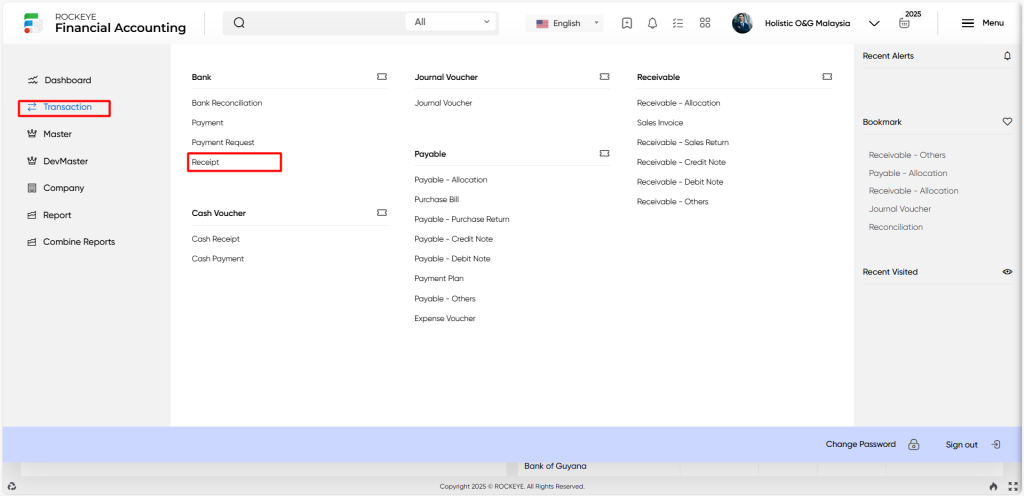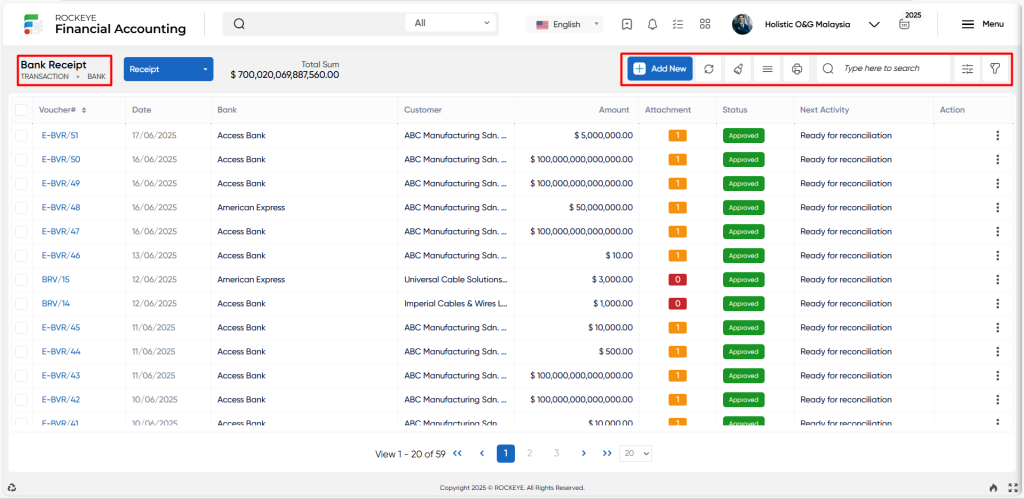Financial Accounting
Bank Receipt
Introduction/Purpose:
A bank receipt is an official document that confirms a payment made to an organisation. It is generated digitally to recognise money received from a client or payer in a bank account.
Dependency:
- Integration with banking systems: The financial management system should be able to integrate with banking systems in order to receive bank transaction data and automatically create bank receipts.
- Integration with accounting systems: Integration with accounting systems allows bank receipt data to be seamlessly sent for further processing, such as general ledger entries and financial statement preparation.
How To Navigate To Bank Receipt:
The navigation includes the following steps for viewing the bank receipt in the financial management system.

- Click on the transactions tab: The transactions can be accessed by clicking on the transactions tab on the side menu.
- Click on the bank receipt: The bank receipt can be accessed by clicking it from the bank section.
Listing:
A bank receipt listing in a financial management system is a feature which provides a list of all bank receipts.

- Users can view the following information in the bank receipt listing
- Voucher and date
- Bank name and its type
- Account/Contact
- Currency
- Exchange rate and amount
- Amount lc
- Attachments
- Reconciled
- Allocated and status
User can perform the following actions
- Add new: The “Add new” function allows you to create and add a new bank receipt to the system.
- Show all listing records: The “Show all listing” function is to display and update a list or collection of bank receipts within a system or interface.
- Clear cache: The “Clear cache” refers to the process of deleting temporary files, data, or stored information that is stored in a cache.
- More options: The “More options” function provides the user with more actions or functionalities.
- Print records: The “Print records” function allows users to print content by opening a print dialogue or displaying a preview of the content to be printed.
- Search: The “Search” function allows the user to look for a specific entry within the available data and presents the results that match the search parameters.
- Quick search: The ”Quick Search” function allows users to quickly search and locate specific bank receipts within the system.
Recording & Update:
Add New Bank Receipt :

- Bank book: The “Bank book” refers to an option where the user must select a bank book associated with the bank receipt.
- Prefix: The “Prefix refers to the prefix or identification number connected with the bank receipt used to record the bank receipt in the financial management system represented by this field.
- Number: The “Number ” refers to the unique number assigned to the bank receipt in while creating the bank receipt in the financial management system.
- Account type: The “Account type” refers to the kind of account that the payment is associated with, such as a general account, a supplier account, or a specific account code.
- Account: The “Account” refers to the bank account associated with the bank receipt. You must select the proper account from a list of options or enter the account information.
- Currency: The “Currency” refers to the currency used to make the payment. Depending on the transaction, it could be local currency or any other international currency.
- Exchange rate: The “Exchange rate” refers to the rate at which one currency is exchanged for another.
- Narration: The “Narration” refers to the area wherein a quick overview or explanation of the bank receipt transaction is provided.
- Amount: The “Amount” refers to the field where the user can enter the receipt amount and specify the transaction’s numerical value.
- Mode: The “Mode” refers to the method or channel by which the payment is made, such as a cheque, cash, or any other payment mode enabled by the financial management system.
- Ref no: The “Reference no” refers to a commonly used term to record a unique reference number associated with the payment, such as an invoice number or a specific identity provided by the beneficiary.
- Ref date: The “Reference date” refers to a date connected with the reference number specified above.
- Ref bank: The “Reference bank” refers to the bank details or the name of the beneficiary or recipient of the payment.
- Contract / Deal: The “contract/deal” refers to the contract if any associated with the bank receipt.
- Profit centre: The “Profit centre” refers to a specific division, department, or project within an organisation to which the bank payment is allocated or attributed.
- Remarks: The “Remarks” refers to a field that allows users to insert any relevant notes or comments concerning the bank payment.
- Attachments: The “Attachment” refers to a field where the user can upload supporting papers or files linked to the bank payment, such as invoices, receipts, or any other necessary paperwork.
Users can perform the following actions
- Submit: The “Submit” function allows the user to submit the required information while creating a new bank receipt.
- Discard: The “Discard” function allows the user to cancel the submission of information provided at the time of creating a new bank receipt.